Fusarium Head Blight (Scab) of Small Grains (PP804, Revised Sept. 2018)
Availability: Web only
Fusarium head blight (FHB), or scab, is a fungal disease that can occur on all small-grain crops grown in North Dakota. The disease is seen most commonly on spring wheat, winter wheat, durum and barley, causing significant reductions in yield and quality.
Yield loss occurs from floret sterility and the production of shriveled, light test-weight kernels. Quality reductions occur from fungal toxins (mycotoxins) that are produced in infected seed. The toxins are unacceptable for certain end uses, and dockage can occur at the point of sale.
Symptoms and Signs
Symptoms in wheat and durum include bleaching of the head (spike). Bleaching may occur on a portion of or the entire head (Figure 1) and is most noticeable in a susceptible variety (Figure 2). The fungus also may infect the stem immediately below the head (peduncle), causing a brown to purplish discoloration of the stem tissue. Signs of Fusarium infections are pink to salmon-orange spore masses often seen on infected spikelets and glumes during prolonged periods of wet weather (Figure 3).
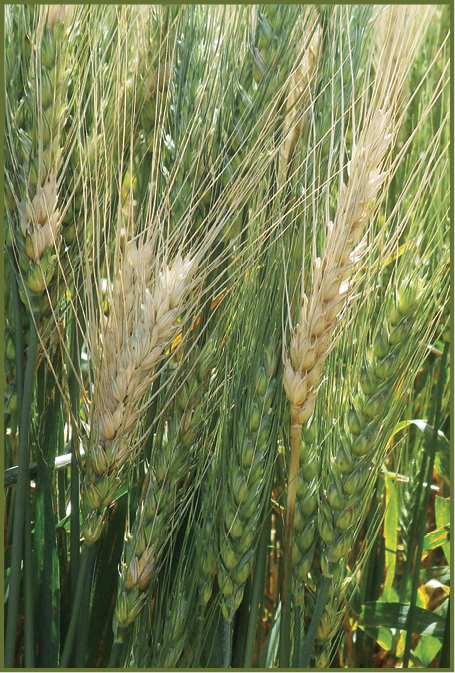
Figure 1. Wheat heads showing bleached spikelets as a result of Fusarium infection. (Andrew Friskop, NDSU)
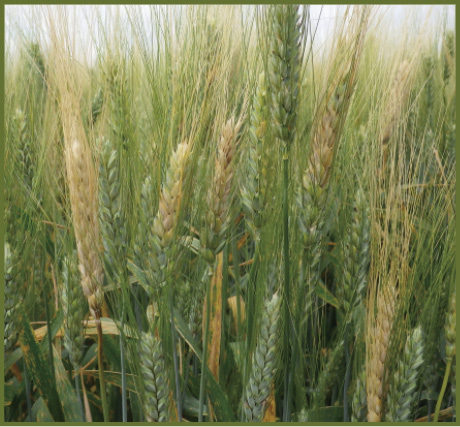
Figure 2. Susceptible durum variety with numerous grain heads with FHB. (Andrew Friskop, NDSU)
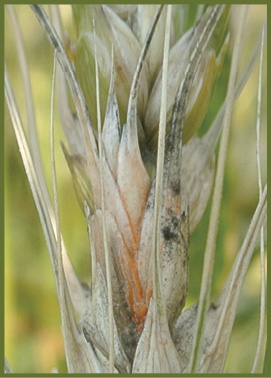
Figure 3. Salmon-orange spores of Fusarium graminearum visible on glumes of wheat. (Andrew Friskop, NDSU)
Infected wheat and durum kernels are shriveled, lightweight and dull grayish or pinkish (Figure 4). These kernels sometimes are called “tombstones” because of their chalky, lifeless appearance. If infection occurs late in kernel development, Fusarium-infected kernels may be normal in size with slight discoloration yet still harbor mycotoxins. Infected kernels of durum often lose their amber translucence and appear chalky or opaque.
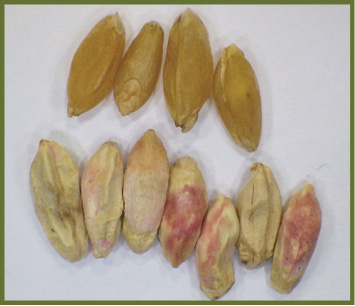
Figure 4. Healthy durum kernels (top) and Fusarium-infected durum kernels (bottom). Note chalky white to pink discoloration of infected kernels. (Andrew Friskop, NDSU)
Symptoms in barley include brown, water-soaked to bleached spikelets (Figure 5A, 5B). Severely infected barley kernels at harvest may show a pinkish discoloration (Figure 6). Although rare, salmon-orange spore masses of the fungus can be seen on the infected spikelet and glumes in barley during prolonged periods of wet weather.
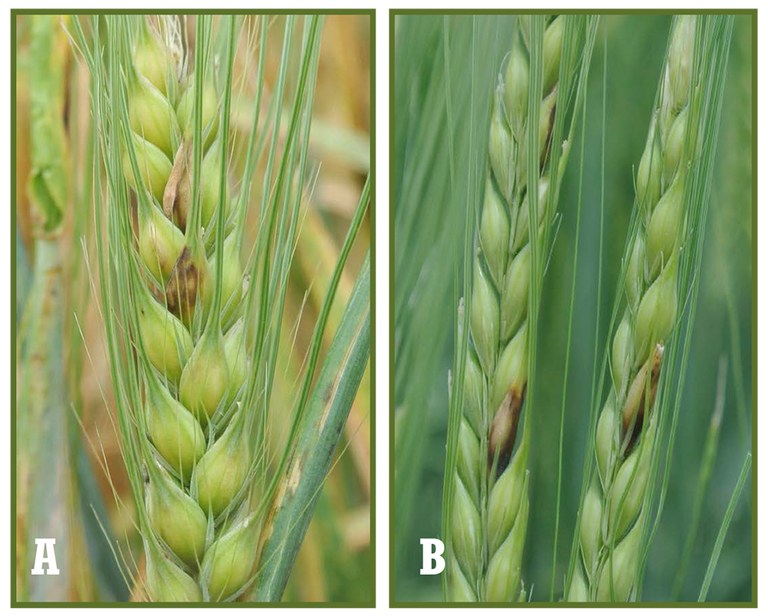
Figure 5. (A) FHB symptoms on six-row barley. (B) FHB symptoms on two-row barley. (Andrew Friskop, NDSU)
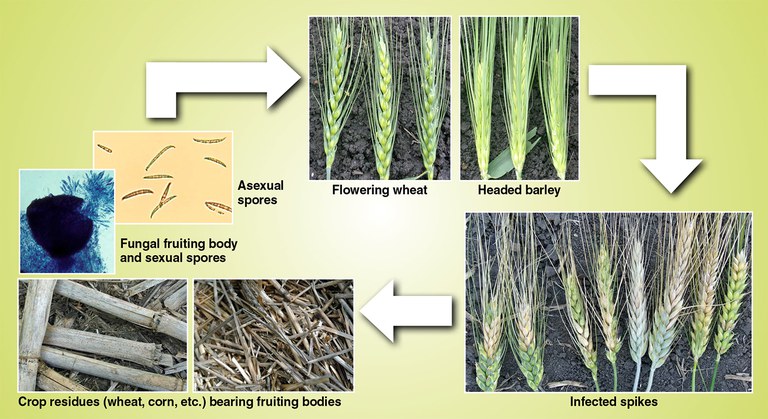
Figure 6. Fusarium head blight disease cycle. (Andrew Friskop and Shaobin Zhong, NDSU)
Estimates of FHB levels in a field are based on counts of blighted heads or kernels. A colored visual scale to estimate the severity of FHB in wheat is available from NDSU Extension (publication PP1095). Samples of diseased heads and/or grain suspected of containing scabby kernels can be submitted to Extension’s county offices or the Plant Diagnostic Laboratory at NDSU (nominal fee) for diagnosis.
Causal Pathogens
Fusarium head blight is caused by fungal species in the genus Fusarium. The most common species causing FHB in small grains is Fusarium graminearum (sexual stage – Gibberella zeae). This fungus is the same one that frequently is associated with stalk rot and ear rot of corn.
Another Fusarium species that causes FHB is Fusarium culmorum. F. graminearum and F. culmorum also may cause root rot of small grains. On barley, two other Fusarium species, F. poae and F. avenaceum, may cause kernel blight.
Survival and Spread
The fungi persist and multiply on infected crop residues of small grains and corn (see disease cycle, Figure 6). During moist weather, spores of the fungi are windblown or splashed onto the heads of cereal crops. Spores can come from within a crop or can be blown from surrounding crops sometimes long distances away.
Wheat and durum crops are susceptible to infection from heading to the hard dough stage but are most susceptible at flowering (anthers are present). Spores of the causal fungus may land on the exposed anthers at flowering time and then grow into kernels, glumes or other parts of the head.
For spring barley (flowers when the head is in the boot stage), infection occurs once the head breaks through the leaf sheath. Infection in either crop may continue until close to grain maturity under favorable environmental conditions for the organism(s).
The most favorable conditions for infection are prolonged periods (48 to 72 hours) of high humidity and warm temperatures (75 to 85 F). However, infection does occur at cooler temperatures when high humidity persists for longer than 72 hours. Early infections may produce air-borne spores, which are responsible for the secondary spread of the disease, especially if the crop has uneven flowering due to late tillers.
Because FHB development depends on favorable environmental conditions, disease occurrence and severity varies from year to year. A combination of factors that may lead to significant yield and quality losses are: abundant inoculum, prolonged or repeated periods of wetness and high humidity during flowering (head emergence in barley) through kernel development, and the use of susceptible cultivars.
Management
FHB is best managed by integrating multiple management tools. The use of a single tool often fails when the environment favors severe disease development. Management strategies to reduce FHB should include a combination of as many of the following practices as possible:
Resistance
None of the available commercial cultivars are immune to Fusarium infection, but differences in reaction to FHB do occur. Two types of resistance, Type I and Type II, are recognized widely.
Type I resistance reduces the number of initial infections and usually is measured by the number of infected spikelets following a spray inoculation. Type II resistance restricts the spread of the fungus in infected tissue and is measured by the number of spikelets infected beyond an initial infection site (a single spikelet). Other types of resistance or tolerance also have been recognized in some wheat lines, based on the ability to resist kernel infection, degrade mycotoxins (DON and others) or maintain yield despite the presence of FHB (tolerance).
Several varieties of hard red spring wheat have improved FHB resistance. However, the level of FHB resistance is much lower in durum than in bread wheat. Barley has natural Type II resistance to reduce the spread of the fungus in infected tissue, and some varieties accumulate lower levels of DON.
Producers in areas of high risk for FHB should select cultivars that have shown some level of resistance to FHB. The latest information on cultivar response to FHB is available in current NDSU variety trial publications and from Extension’s county offices.
Seed Treatment
A fungicide seed treatment will not protect against Fusarium head blight, but it can reduce seedling blight if a scabby seed source is used. If a scabby seed source is used, make sure to clean the seed source thoroughly, consider using a fungicide seed treatment, conduct a germination test and adjust plant populations accordingly.
Tillage
Tillage practices that bury residue from small grains or corn reduce the inoculum potential of the fungus. In minimum- or no-till practices, effective spreading and distribution of chaff and other residue may allow faster decomposition of the chaff, reducing inoculum potential. Chopping or grinding corn residue to reduce the size of the remaining stalk pieces also may favor disintegration of infected tissue.
Crop Rotation
Crop rotation is effective in reducing FHB levels. Crop rotation to a nonhost crop or planting small grains in a field that previously was planted to a broadleaf crop should be considered. The greatest risk of FHB is when small grains are planted on last year’s Fusarium-infected small-grain residue or on last year’s corn residue. Species of Fusarium that cause FHB (and in particular F. graminearum) also attack corn, causing stalk, root and ear rot, and survive for several years in corn residue.
Planting Date
Staggered planting of the small-grain crop or planting cultivars differing in days to maturity is advised; this reduces the risk of a producer’s entire crop flowering or going through early grain fill during a period favorable for FHB development.
Fungicide
Triazole fungicides (fungicide resistance group 3) are recommended for FHB suppression because they are locally systemic and have been shown to reduce FHB and DON. A well-timed fungicide may help reduce FHB damage. Reductions in FHB severity of 50 to 60 percent can be achieved when fungicides are applied at early flowering for wheat and durum, and at full head in barley (Figures 7 and 8).
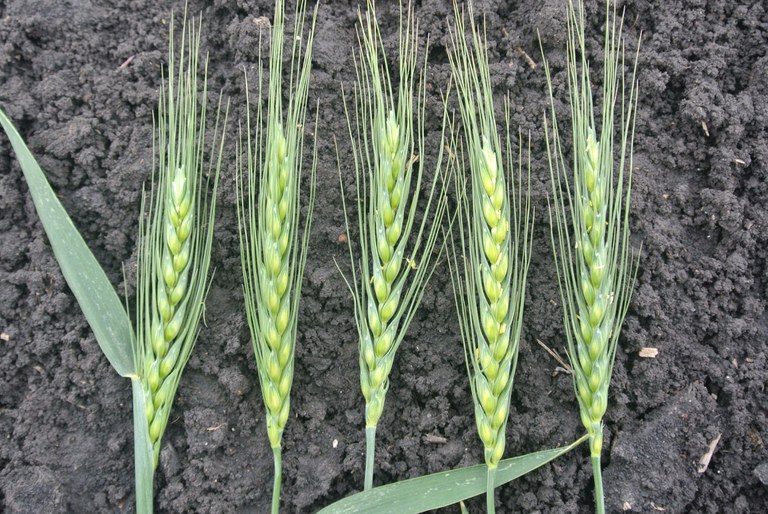
Figure 7. Wheat growth stages from left are three-fourths spike emergence, full spike, early flowering, one to three days after early flowering and three to seven days after early flowering. (Andrew Friskop, NDSU)
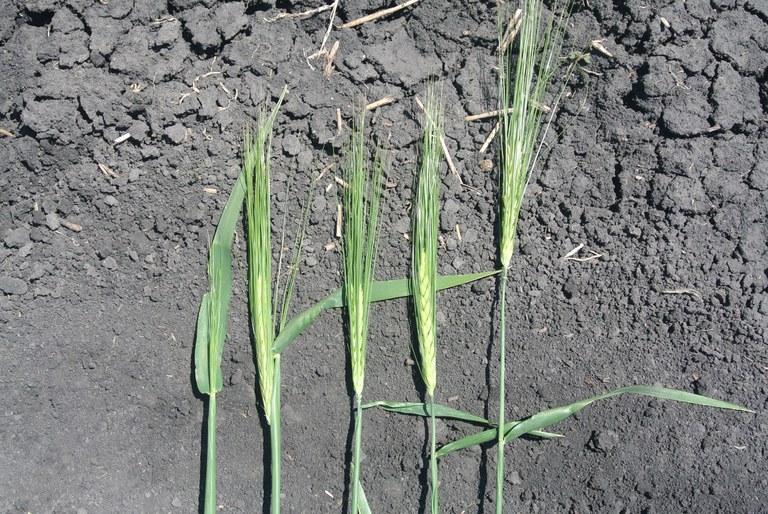
Figure 8. Barley growth stages from left are boot stage, one-half spike emergence, full spike, one to three days after full spike and three to seven days after full spike. (Andrew Friskop, NDSU)
Applying a fungicide four to seven days after early flowering in wheat (full head in barley) still can suppress FHB. When making late applications, make sure to consider the harvest restriction interval for the fungicide that is used.
Application studies have shown that spray coverage and disease control with these fungicides is improved when the sprays are directed at an angle forward and backward toward the grain head, or with single nozzles directed toward the grain head, all at a 30-degree angle from the horizontal.
A multistate scab forecasting model and a North Dakota forecasting model are available to help predict the risk of Fusarium head blight during the growing season. The use of these forecasting models helps in the decision whether to use fungicides. The websites for these models are:
Harvest
At harvest, the combine may be adjusted so that lightweight FHB kernels are removed along with the chaff. However, this will not remove all FHB kernels because some Fusarium infections occur late in kernel development, and these infected kernels still will be fairly plump.
Infected barley and oat kernels are not removed easily in the combining process. The Federal Grain Inspection Service considers visible FHB damage as part of total kernel damage and, if excessive, will lower the market grade. Severely affected grain may be graded “feed” rather than “milling” for wheat or “malting” for barley.
After the harvest of wheat, gravity table grain separation may be very effective in removing lightweight, FHB-damaged kernels. The resultant product may have a high enough test weight to pay for the cost of the clean-out process.
Mycotoxin
FHB-infected grain may contain fungus-produced toxic substances called mycotoxins. The most common mycotoxin associated with Fusarium-infected grain in the northern Great Plains is deoxynivalenol or DON (vomitoxin). This mycotoxin may cause vomiting and feed refusal in nonruminant animals, such as pigs.
The presence of this toxin may result in substantial price discounts at the market and even refusal to purchase if DON toxin levels are high. In the case of barley used by the malting and brewing industry, DON level requirements are very low, generally less than 0.5 part per million (ppm; milligrams/kilogram).
The presence of Fusarium-infected grain does not automatically mean mycotoxins are present. The occurrence, amount and kind of mycotoxins may depend on several factors, including environment, species of fungus present, severity of infection and the variety or kind of crop. Fusarium-infected grain may be tested for DON and other mycotoxins at properly equipped laboratories.
Contact a veterinarian or feed specialist for further information on safe livestock feeding levels. The risk of human exposure to DON ingestion is minimal under the Food and Drug Administration (FDA) guidelines (see adjacent table), but producers and elevator operators need to be aware that moldy grain can cause allergy and breathing problems. Producers and elevator operators should wear a good-quality dust mask when working around grain with high amounts of scab or other molds.
The FDA has established the following advisory levels for DON in food and feed:
- 1 ppm for finished grain products for human consumption
- No standard for raw grain going into milling process
- Cattle more than 4 months old: 10 ppm (providing grain at that level doesn’t exceed 50 percent of diet)
- Poultry: 10 ppm (providing grain at that level doesn’t exceed 50 percent of diet)
- Swine: 5 ppm (not to exceed 20 percent of ration)
- All other animals: 5 ppm (providing grains don’t exceed 40 percent of diet)
This publication was authored by Marcia P. McMullen, former NDSU Extension cereal pathologist; Shaobin Zhong; and Stephen Neate, former NDSU barley pathologist, 2008.

Revised Sept. 2018

